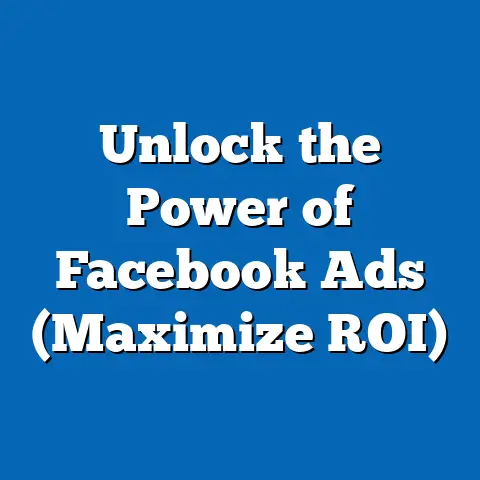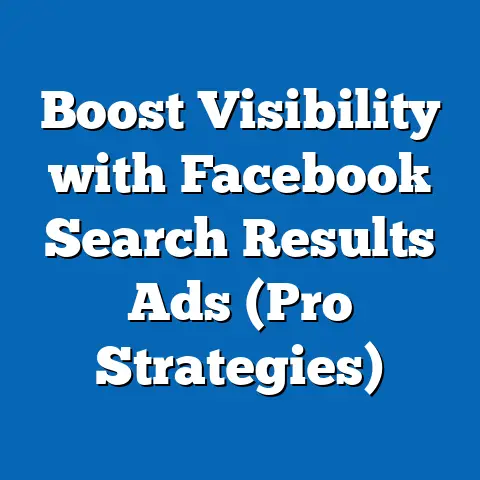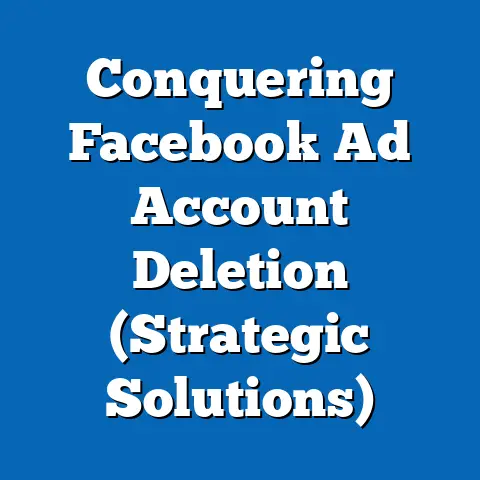Unlocking Facebook Ad Costs in India (Expert Insights)
Have you ever wondered how the digital landscape has transformed political outreach in India, a country with over 1.4 billion people and a vibrant democratic tradition? As political campaigns increasingly shift to social media platforms like Facebook, understanding the cost dynamics of advertising on such platforms is crucial for grasping how political messages are crafted and targeted. In this comprehensive analysis, we delve into the intricacies of Facebook ad costs in India, exploring their implications for political engagement while examining the demographic makeup, core beliefs, voting patterns, and distinguishing characteristics of key political groups in this context.
The Rise of Digital Political Campaigning in India
India’s political landscape has undergone a seismic shift with the advent of social media as a primary tool for political campaigning. With over 400 million active Facebook users as of 2023, India is the platform’s largest market globally, according to Statista data. This massive user base makes Facebook a critical arena for political parties and candidates to reach voters, especially in a country where traditional media like television and print still dominate but are increasingly supplemented by digital outreach.
The cost of advertising on Facebook in India, while relatively low compared to Western markets, varies significantly based on factors such as target demographics, geographic location, and campaign objectives. According to a 2022 report by Social Samosa, the average cost-per-click (CPC) for Facebook ads in India ranges between INR 0.50 to INR 2.50 (approximately USD 0.006 to USD 0.03), with costs spiking during election seasons due to heightened demand. This affordability has democratized access to political messaging, allowing smaller parties and independent candidates to compete with larger, well-funded organizations.
However, the implications of these costs go beyond mere numbers—they shape how political groups target specific voter segments and craft their narratives. To understand this dynamic, we must first analyze the key political groups in India, their demographic compositions, and how digital strategies align with their core beliefs and voting behaviors. This intersection of technology and politics reveals critical insights into the evolving nature of Indian democracy.
Key Political Groups in India: A Demographic and Ideological Breakdown
1. Supporters of the Bharatiya Janata Party (BJP)
Demographic Composition: The BJP, India’s ruling party as of 2023, draws significant support from urban and semi-urban populations, particularly among the Hindu majority, which constitutes about 79.8% of India’s population according to the 2011 Census. Data from the 2019 Lok Sabha elections, analyzed by the Centre for the Study of Developing Societies (CSDS), shows that the BJP’s voter base is predominantly male (55% of its voters), aged between 25-40 years, and includes a substantial share of upper-caste Hindus (around 60% of its support). Additionally, the party has made inroads among Other Backward Classes (OBCs) and Scheduled Castes (SCs), with 44% and 34% of these groups voting for BJP in 2019, respectively.
Core Beliefs and Values: The BJP’s ideology is rooted in Hindutva, a form of Hindu nationalism that emphasizes cultural and religious identity. The party advocates for policies promoting national unity, economic liberalization, and a strong stance on national security, as evidenced by its focus on issues like the revocation of Article 370 in Jammu and Kashmir. Its messaging often resonates with voters seeking a blend of traditional values and modern development.
Voting Patterns and Political Engagement: The BJP has dominated national elections since 2014, securing 37.4% of the vote share in 2019, per Election Commission of India (ECI) data. Its supporters are highly engaged on social media, with the party spending over INR 27 crore (approximately USD 3.3 million) on digital ads during the 2019 elections, according to Facebook’s Ad Library. This digital savviness allows the BJP to target specific demographics with tailored messages, often leveraging low-cost Facebook ads to reach rural and young voters.
Policy Positions on Major Issues: The BJP prioritizes infrastructure development, digital economy initiatives like Digital India, and social welfare schemes such as the Pradhan Mantri Awas Yojana (housing for all). On contentious issues like citizenship laws (e.g., the Citizenship Amendment Act), its policies often polarize public opinion but solidify its core base.
Distinguishing Features: Unlike other parties, the BJP’s strength lies in its organizational discipline and ability to mobilize voters through a blend of grassroots networks and digital campaigns. Its focus on cultural nationalism sets it apart from secular-leaning parties like the Indian National Congress (INC).
2. Supporters of the Indian National Congress (INC)
Demographic Composition: The INC, India’s oldest political party, has a more diverse voter base, drawing support from rural areas, minorities (Muslims, who form 14.2% of the population per the 2011 Census), and lower-income groups. CSDS data from 2019 indicates that 40% of INC voters are from rural areas, and the party retains significant support among older voters (above 50 years) and Scheduled Tribes (STs), with 25% of STs voting for INC. Women also form a substantial part of its base, accounting for 48% of its voters.
Core Beliefs and Values: The INC champions secularism, social justice, and inclusive development. Its historical role in India’s independence movement shapes its narrative as a party of unity and diversity, often positioning itself as a counterweight to the BJP’s Hindu nationalist ideology.
Voting Patterns and Political Engagement: The INC’s vote share dropped to 19.5% in 2019, per ECI data, reflecting a decline in influence compared to its historical dominance. However, it remains competitive in state elections and has invested in digital campaigns, spending INR 14 crore (approximately USD 1.7 million) on Facebook ads in 2019, though its online engagement lags behind the BJP’s.
Policy Positions on Major Issues: The INC emphasizes welfare programs like the Mahatma Gandhi National Rural Employment Guarantee Act (MGNREGA) and advocates for minority rights and economic equity. Its stance on issues like farm laws often aligns with rural and agricultural communities.
Distinguishing Features: The INC’s emphasis on secularism and historical legacy differentiates it from the BJP. However, its perceived lack of organizational cohesion and weaker digital presence compared to the BJP often hampers its outreach, especially among younger voters.
3. Regional Party Supporters (e.g., Aam Aadmi Party, Trinamool Congress)
Demographic Composition: Regional parties cater to specific linguistic, cultural, or state-based identities. For instance, the Aam Aadmi Party (AAP) in Delhi and Punjab draws support from urban middle-class and working-class voters, with 60% of its 2022 Punjab Assembly election voters aged 25-45, per CSDS surveys. Trinamool Congress (TMC) in West Bengal has a strong rural and female voter base, with women constituting 52% of its supporters in the 2021 state elections.
Core Beliefs and Values: These parties prioritize local issues and governance over national ideologies. AAP focuses on transparency and public services like education and healthcare, while TMC emphasizes Bengali cultural identity and opposition to central overreach.
Voting Patterns and Political Engagement: Regional parties collectively secured 30% of the national vote share in 2019, per ECI data, often acting as kingmakers in coalition politics. Their digital engagement varies, with AAP spending significantly on Facebook ads (INR 2 crore in 2022 Punjab elections), while others rely more on traditional campaigning.
Policy Positions on Major Issues: Policies are region-specific—AAP’s free electricity and water schemes in Delhi, for instance, contrast with TMC’s focus on rural welfare and opposition to BJP’s central policies.
Distinguishing Features: Unlike national parties, regional groups focus on hyper-local issues, often positioning themselves as alternatives to both BJP and INC. Their digital ad strategies are less extensive but highly targeted to specific constituencies.
Facebook Ad Costs in India: A Detailed Breakdown
Cost Dynamics and Variations
The cost of running Facebook ads in India is influenced by multiple factors, including audience size, competition, and timing. As per a 2023 report by Digital Vidya, the average cost-per-thousand-impressions (CPM) ranges from INR 5 to INR 25 (USD 0.06 to USD 0.30), while CPC can spike to INR 5 during high-demand periods like elections. Urban areas like Mumbai and Delhi see higher costs (CPM of INR 15-20) compared to rural regions (CPM of INR 5-10) due to greater competition and higher internet penetration.
Political campaigns often target specific demographics, such as young voters (18-24 years), who form 15% of India’s electorate, per ECI data, and are highly active on social media (70% usage rate, per Pew Research 2022). Targeting such groups increases ad costs due to high engagement rates but offers significant returns in terms of reach and influence.
Strategic Implications for Political Groups
For the BJP, low ad costs enable micro-targeting of diverse voter groups, such as rural Hindus or urban youth, with tailored messages on development or cultural issues. The INC, with a smaller digital budget, focuses on broader campaigns emphasizing secularism, often targeting minority and rural voters where costs are lower. Regional parties like AAP use cost-effective ads to focus on local issues, leveraging precise geographic targeting to maximize impact within limited budgets.
Experts note that the affordability of Facebook ads in India levels the playing field to some extent. “Even smaller parties can reach millions with a modest budget of INR 1 lakh, something unimaginable in traditional media,” says digital marketing analyst Priya Sharma in a 2023 interview with Business Standard. However, the BJP’s superior funding and data analytics capabilities often give it an edge in optimizing ad spend for maximum electoral impact.
Challenges and Ethical Concerns
While low ad costs democratize access, they also raise concerns about misinformation and unregulated spending. A 2022 study by the Internet Freedom Foundation found that 40% of political ads on Facebook during state elections contained misleading claims, often amplified by low-cost ad buys. Additionally, the lack of transparency in ad funding—despite Facebook’s Ad Library—poses challenges in tracking influence campaigns, particularly during elections.
Intersections of Digital Ads with Demographics and Political Views
Age and Education
Younger voters (18-34 years), who form 34% of India’s electorate (ECI 2023), are the most active on Facebook, with 80% using the platform regularly, per Pew Research. This group is more likely to engage with BJP’s development-focused ads, as 50% of this age cohort voted for the party in 2019 (CSDS data). Educated urban youth, particularly those with college degrees (12% of the population, per 2011 Census), also lean toward AAP in urban centers due to its governance-focused messaging.
Older voters (above 50 years), less active on social media (30% usage rate, Pew 2022), are harder to reach via Facebook ads and remain a stronghold for INC, especially in rural areas. This digital divide shapes how parties allocate ad budgets, with BJP and AAP focusing on younger, tech-savvy groups, while INC struggles to adapt.
Race, Religion, and Region
Religious demographics play a significant role in ad targeting. BJP’s campaigns often appeal to Hindu voters with cultural messaging, evident in its 2019 ad spend of 60% targeting Hindi-speaking states like Uttar Pradesh, per Facebook Ad Library. INC and regional parties like TMC target minority communities (Muslims, Christians) with ads on secularism and welfare, often in regional languages to reduce costs and increase relevance.
Regional disparities also influence ad strategies. High internet penetration in southern states like Kerala (54%, per TRAI 2022) allows parties to run cost-effective campaigns compared to northern rural areas with lower connectivity (20%). This creates a digital divide in political outreach, often benefiting parties with urban strongholds.
Areas of Consensus and Division
Across political groups, there is consensus on the importance of digital outreach, with 90% of major parties investing in social media ads, per a 2022 CMS report. However, divisions arise in content—BJP’s focus on nationalism often clashes with INC’s secular messaging, while regional parties prioritize local grievances. These ideological divides are amplified by targeted ads, as low costs allow parties to reinforce echo chambers rather than foster dialogue.
Comparative Analysis: Digital Strategies Across Political Groups
The BJP stands out for its sophisticated use of data analytics and high ad spend, enabling it to reach diverse demographics with personalized content. Its 2019 campaign, for instance, used over 50,000 unique ads on Facebook, per Ad Library data, compared to INC’s 20,000. This volume, combined with low CPC rates, maximizes its visibility among both urban and rural voters.
The INC, while increasing its digital presence, lacks the BJP’s scale and often struggles to counter polarizing narratives online. Its ad content focuses on broad themes like unemployment (40% of its 2019 ads, per Ad Library), which resonate with rural and minority voters but fail to engage younger, urban audiences as effectively.
Regional parties adopt a hybrid approach, balancing digital and traditional methods. AAP’s success in Delhi and Punjab highlights the efficacy of low-budget, high-impact ads (e.g., INR 50,000 campaigns reaching 1 million users), focusing on governance metrics. TMC, however, relies more on ground campaigns, using digital ads sparingly to reinforce local identity.
Historical and Social Context
The shift to digital campaigning in India must be understood within the broader context of its democratic evolution. Since the 1990s, coalition politics and the rise of regional parties have fragmented voter bases, necessitating targeted outreach—something social media facilitates at low cost. The BJP’s digital dominance mirrors its organizational growth post-2014, while INC’s lag reflects its historical reliance on legacy networks over modern tools.
Socially, India’s rapid urbanization (35% urban population in 2023, per World Bank) and youth bulge (median age of 28, per UN data) create fertile ground for digital politics. However, disparities in internet access—only 43% of Indians are online, per TRAI 2022—mean that digital ads complement rather than replace traditional campaigning, shaping a hybrid political landscape.
Conclusion: The Future of Digital Politics in India
Unlocking the dynamics of Facebook ad costs in India reveals not just financial intricacies but also the evolving nature of political engagement in a diverse democracy. With costs as low as INR 0.50 per click, parties across the spectrum can reach millions, though disparities in funding and digital expertise create uneven playing fields. The BJP’s dominance, INC’s struggle, and regional parties’ localized strategies highlight how ad costs intersect with demographic and ideological divides.
As India heads toward future elections, the role of platforms like Facebook will only grow, raising questions about regulation, misinformation, and equity in digital access. Supported by data from ECI, CSDS, and industry reports, this analysis underscores that while low ad costs democratize outreach, they also amplify polarization and ethical challenges. Understanding these trends is essential for stakeholders aiming to navigate or reform India’s digital political arena, ensuring that technology serves as a tool for inclusion rather than division.
This exploration, spanning demographic breakdowns, voting patterns, and cost analyses, offers a foundation for further research into how digital tools reshape political power in the world’s largest democracy. As social media continues to evolve, so too must our understanding of its costs—both financial and societal.





